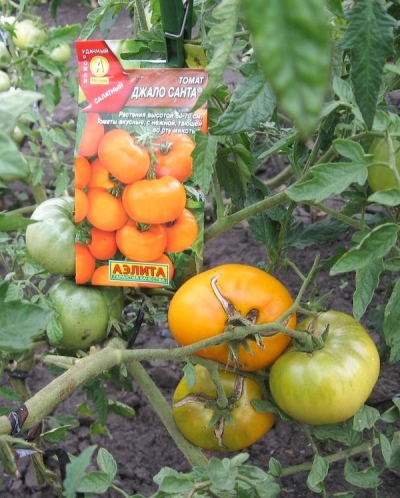
- Authors: Kachainik V.G., Gulkin M.N., Karmanova O.A., Matyunina S.V.
- Year of approval: 2015
- Category: grade
- Growth type: indeterminate
- Appointment: fresh consumption
- Ripening period: mid-season
- Ripening time, days: 110-117
- Growing conditions: for open ground, for film greenhouses
- Bush height, cm: 60-70
- Foliage: weak
The Djalo Santa tomato combines many positive qualities that are highly valued by gardeners. Large and juicy fruits pleased not only with a wonderful taste, but also with simple agricultural technology and unpretentiousness. This vegetable crop has been known since 2015, it was patented by the representatives of the company "Aelita", in the same year it was included in the State Register.
Description of the variety
The bushes are low and reach only 60-70 centimeters. Leafiness is weak. Shoots are covered with medium-sized, dark green leaves. The variety is recommended to be grown in plastic greenhouses or in open field conditions. Ripe tomatoes are recommended to be eaten fresh. Due to their compact size, the bushes will feel great when cultivated in a small greenhouse or in a small area.
The main qualities of the fruit
Unripe tomatoes are green with a bright green spot at the stalk. As it ripens, the color changes to a rich yellow. The sizes are marked as large, and in weight gain about 120 grams, some fruits can grow up to 170 grams. Shape - rounded, slightly flattened, slight ribbing is observed. The type of inflorescence is simple. The average number of seed nests is 5. Under the glossy skin, a delicate and soft pulp is hidden.
Taste characteristics
Ripe fruits boast excellent taste characteristics. The fruits are sweet and fleshy, juicy on the inside.
Ripening and fruiting
The Djalo Santa tomato is considered mid-season, and the ripening period is 110-117 days.
Yield
Vegetable culture is high-yielding. From one square meter of the plot, 6.5 to 7 kilograms of vegetables are harvested. Such high results can be achieved only with proper cultivation and compliance with all conditions of agricultural technology.
The timing of planting seedlings and planting in the ground
Sowing seeds for seedlings should be done about 2 months (50-60 days) before the young plants are planted in open ground or in a greenhouse. The recommended dates are from March 20 to April 10. For germination, choose soil with organic additives such as peat, compost or manure.
To avoid picking and not to damage young plants during transplanting, you can immediately germinate the seed in separate containers. Otherwise, you will need to carry out the planting as soon as 1-2 true leaves appear on the seedling. When growing seedlings, the seeds are deepened into the ground by 0.5 centimeters. The seedlings should receive enough light, whether it be natural sunlight or artificial light.
Regular and moderate watering is also of great importance. Containers with seedlings are irrigated only when the soil dries out. Excess moisture will negatively affect the condition of the root system. Nutrient dressings are also used. Plants are fertilized 2-3 times throughout the growing period using complex fertilizers.
In order for young plants to quickly adapt to a new place, they should be hardened in advance. This is done about 7 days before planting the bushes in the ground. So the tomatoes will get used to the new temperature regime and will fully develop.
As for planting plants in the ground, manufacturers recommend dates from May 15 to July 5. The weather conditions in the area must be taken into account. The selected area is pre-prepared. It should be cleaned and dug up, removing weeds. When transplanting, the earthen lump is left intact, and each plant is placed in a separate hole. After planting, the bushes are watered abundantly.

Growing tomato seedlings is an extremely important process, because it largely depends on whether the gardener can harvest at all. All aspects must be taken into account, from seedbed preparation to planting in the ground.
Landing scheme
On one square meter of the site, you can germinate from 4 to 5 bushes. Leave a gap of 0.5 meters between the plants.

Growing and care
For a high-yielding variety, you need to choose the right future cultivation place. The tomato loves bright, but soft and diffused light. It is advisable to abandon the beds in the shade, since the lack of sunlight has a bad effect on the quality and quantity of the crop. It is important that the site is not located in a lowland, which can cause stagnant moisture. Dampness provokes the development of the fungus, and also often causes the death of the plant.
To saturate the soil with useful substances and trace elements, green manures are sown at the site of growing future tomatoes. They not only enrich the soil, but also protect the plants of the Solanaceae family from infections and diseases.
Tomatoes should be fed regularly. The minimum amount of fertilization is 2 times per season. If possible, it is advisable to make special formulations 1-2 times a week. Complex fertilizers have a positive effect on the fruiting and taste of vegetables.
Experienced summer residents are advised to make a choice in favor of complex feeding. The drug nitrophoska, which is rich in phosphorus, nitrogen and potassium, has become widespread. These elements are essential for the healthy growth of tomatoes. And you can also use organic matter (ash, horse manure or bird droppings).




A plant needs different micronutrients at each stage of growth. All fertilizers can be divided into two groups: mineral and organic. Folk remedies are often used: iodine, yeast, bird droppings, eggshells.
It is important to observe the rate and period of feeding. This also applies to folk remedies and organic fertilizers.



























































































